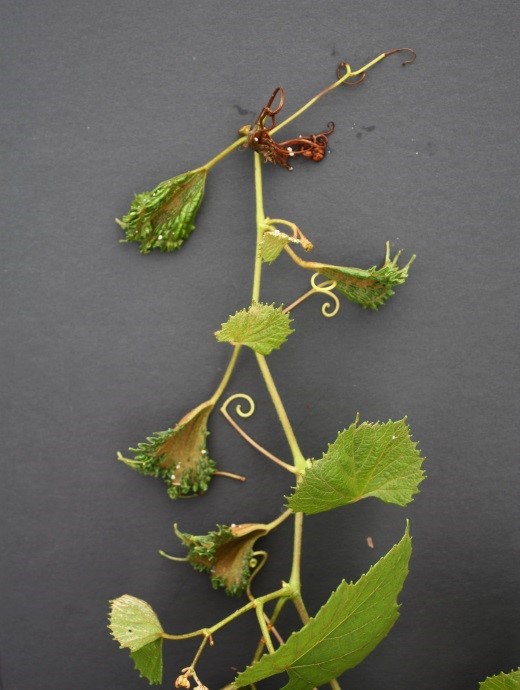Taking an environmentally sensitive approach to pest management
Understanding Herbicide Drift Issues
Published: July 31, 2017
Several reports of herbicide injury on high-value ornamental and specialty crops due to drift from products containing dicamba, glyphosate, and 2,4-D have been in the news lately. Dicamba and 2,4-D are older herbicides used primarily for post-emergent control of broadleaf weeds. Dicamba was first developed in 1942, but not released until 1965. This herbicide is registered for use on several crops, including asparagus, barley, corn, cotton, sorghum, soybean, and wheat. It can also be used in conservation reserve programs, fallow croplands, hay, pasture land, and is found in some lawn care products. 2,4-D was developed during World War II at the Rothamsted Experiment Station in Great Britain and became commercially available in 1946. Unfortunately, some of the older formulations of dicamba and 2,4-D are volatile and can drift onto non-target plants, causing injury. Glyphosate (active ingredient in Roundup) was discovered in 1970 and is widely used for post-emergent control weeds. Over the years, with repeated use of these products, herbicide resistant weeds have evolved, posing a significant threat to corn and soybean production in the Midwest.
Because of the high expense of herbicide development, some crop plants, such as soybean, corn, and cotton, have been genetically-modified, making them tolerant to specific herbicides. Also, new formulations of 2,4-D and dicamba have been developed with reduced volatility. Label instructions direct users to apply these products when the wind speed is 3 to 10 mph using approved nozzles on a boom at a specified height, and to maintain a buffer to protect other sensitive plants. Another precaution against drift is to avoid application of herbicides under conditions favorable for a temperature inversion. A temperature inversion occurs when cold air near the soil surface is trapped below a layer of warm air. When certain herbicides are applied during a temperature inversion, vertical air movement is restricted, causing the suspended herbicide droplets to remain in a concentrated cloud. This cloud can then move in unpredictable directions due to the variability of wind direction. Temperature inversions commonly occur on clear nights or with limited cloud cover and little wind. Inversions begin to form when the sun sets and continue into the morning, forming foggy conditions.

Figure 1. Dicamba damage on 'Norton' grapevine two weeks after application.
Various symptoms of dicamba or 2,4-D injury on sensitive crops may include foliar stunting or abnormal elongation, cupping or parallel venation of leaves, foliar chlorosis (yellowing), shortened internodes, or twisting, callusing, splitting or cracking of stems or petioles (Figure 1). Factors influencing the severity of damage include the plant species, time of year, age of the plant, degree of exposure, environmental conditions at the time of herbicide application, and the herbicide applied. Also, injury symptoms may be immediate or delayed for a year. Some herbicide-damaged plants can recover with time. Observations at the University of Missouri indicate that grape, peach, and elderberry are among the more susceptible fruit crops to dicamba damage. Grape, elderberry, viburnum, walnut, and dogwood exhibit sensitivity to 2,4-D + glyphosate.
If you suspect herbicide injury, the date damage was observed and photographs of the affected plants are important. Consider contacting the Missouri Department of Agriculture Bureau of Pesticide Control. Procedures for investigating possible pesticide misuse can be found in the MDA pesticide incidient report form. Maps of the affected area, weather details, and plant samples will aid investigators. Plant samples should be taken as soon as possible since some herbicides dissipate within three weeks after application. Samples can be frozen for later analysis or sent to a lab for verification of herbicide residue. A state investigation might result in fines against the applicator, but doesn't result in compensation for loss of yield or damage.
To seek compensation for economic loss resulting from herbicide injury, first contact the individual responsible for the damage. Most commercial pesticide applicators and many farmers carry liability insurance that will cover all or part of the loss. If a satisfactory settlement is not attained, then consider contacting an attorney.
Subscribe to receive similar articles sent directly to your inbox!
- New Bedding Plants for 2025 (03/11/25)
- Winter Plant Protection (12/03/24)
- August Gardening Tips (07/29/24)
REVISED: February 21, 2017